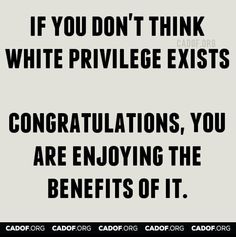
Image from Quote Addicts
In 1988, Peggy McIntosh wrote a famous piece called, “White Privilege: Unpacking the Invisible Knapsack.”1 In the essay, she discusses how belonging to advantaged groups, like white people or men, contributes to the ways that we navigate and perceive our worlds. She makes a stirring point about how easy it is to recognize racism, but that we often have a difficult time seeing how we may be advantaged due to the existence of that racism. You don’t not need to be engaging in racist behavior, using racial epithets or endorsing the bigotries of others in order to be advantaged by societal attitudes. The sad thing, McIntosh points out, is that people who are oppressive in their societal roles are often unaware that they are occupying roles at all.
For instance, people don’t readily recognize that they are more likely to hire white people over people of color, but research shows that this is indeed the case.2 When researchers sent out identical resumes, but with black or white sounding names, people with white sounding names received 50% more interview requests.2 White people are often convinced that anti-white sentiment is actually becoming a bigger problem than anti-black bias, and that attempts to decrease racism are a “zero-sum game” that increases bias towards whites.3 And that’s pretty damn troubling, y’all. As Jen pointed out last week, implicit bias against black people, and black men in particular, results in a larger number of escalated police encounters. While white people are becoming increasingly concerned about being blamed for the problems of minorities, black people are literally worried about being killed in the middle of the day during a routine traffic stop.
As per usual, arguments that equate racism and “reverse racism”* present a false equivalence: there is no systematic disadvantage to being white. White people are armed with our invisible knapsack of privilege. We dominate accounts of history, we see images that look like ourselves everywhere and we can be assured that when things don’t go our way, it is likely not because we’re white. Peggy McIntosh so eloquently hits on the subtlety of privilege in her essay, so I will borrow some of her words. “I can go shopping alone most of the time, pretty well assured that I will not be followed or harassed,” “When I am told about our national heritage or about ‘civilization,’ I am shown that people of my color made it what it is,” “I am never asked to speak for all the people of my racial group,” “I can easily buy posters, postcards, picture books, greeting cards, dolls, toys and children’s magazines featuring people of my race,” and “I can be sure that if I need legal or medical help, my race will not work against me.”
What McIntosh is tapping into here is how unrecognizable the receipt of privilege is. We are not aware that it is happening unless we attempt to be aware of it. We enjoy these invisible privileges, and resent others for suggesting that we have such privileges at all. Even within the context of our presidential election, we have one candidate who is recognizing the disadvantages that black citizens are experiencing on all levels of the legal system, and we have another suggesting that a racist, unconstitutional policy should be widely implemented in order to restore “law and order” to our cities.
For some, the solution is this simple. Black neighborhoods are more violent, therefore black people are more violent, therefore we need to police them with more vigor. For others, there is recognition that the problems in black neighborhoods have much to do with the lack of white privilege. Lack of access to quality education, lack of exposure to suitable role models, lack of mentorship from non-family members, lack of networking contacts in hiring positions, lack of parental free-time to help with home education…You could go on for days. The fact is that there is a flip side to implicit bias, and it’s this kind of implicit inflation. There’s a famous saying, “He was born on third base and thinks he hit a triple.” Sometimes, we simply can’t take credit for everything that we have. We didn’t pull ourselves up by our bootstraps. Sometimes, we received some of those things simply because we are white, or we at least had easier access to them because we have racial privilege. And make no mistake, there are plenty of kinds of privilege. Class, male, and heterosexual privilege all exist as well. People who are advantaged in one domain are not necessarily advantaged in all domains.
In election years in particular, it’s important to recognize where our thinking may suggest that we have a narrow perspective on the issue. Barack and Michelle Obama have recently talked about how third-party votes in this election are votes for Donald Trump. People who disagree have taken to online forums declaring that they are simply voting their conscience, and not violating their own sense of integrity. Well, the next president will choose at least 2 Supreme Court justices, will have access to the nuclear codes and has the ability to set women’s, minority and LGBT rights back by several years. But at least you can tuck your integrity into your invisible knapsack.
*In quotes, because it doesn’t exist. Anti-white bias, prejudice or discrimination, sure, but not racism, due to a lack of systematic disadvantage due to being white.
- McIntosh, P. (1988). White privilege: Unpacking the invisible knapsack. Race, class, and gender in the United States: An integrated study, 4, 165-169.
- Bertrand, M., & Mullainathan, S. (2004). Are Emily and Greg more employable than Lakisha and Jamal? A field experiment on labor market discrimination. The American Economic Review, 94(4), 991-1013.
- Norton, M. I., & Sommers, S. R. (2011). Whites see racism as a zero-sum game that they are now losing. Perspectives on Psychological Science, 6(3), 215-218.

